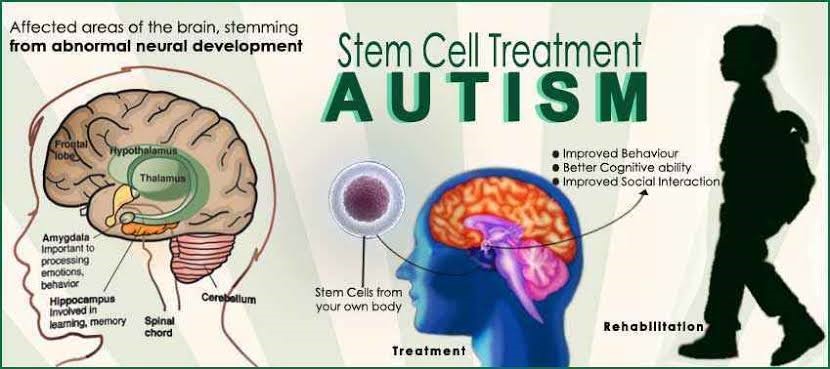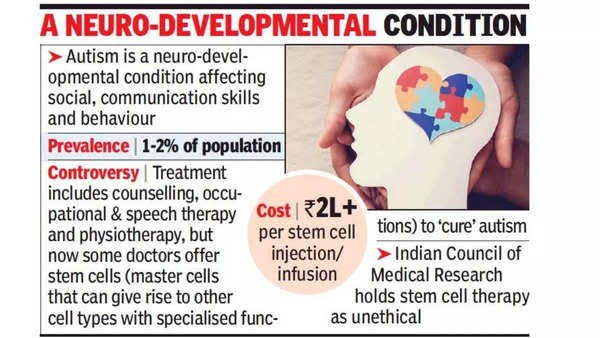Description

Disclaimer: Copyright infringement not intended.
Context: The Delhi High Court Thursday permitted two children with autism spectrum disorder (ASD) to undergo stem cell therapy for treatment of their condition.
Background
- The petition was moved by family members of the two children, challenging the recommendation of the Ethics and Medical Registration Board (EMRB) of the National Medical Commission (NMC) against the use of stem cell treatment for ASD.
- The EMRB recommendation: The use, promotion and advertisement of stem cell treatment shall amount to professional misconduct.
- Result of the recommendation: The children’s doctors stopped the stem cell treatment.
About stem cells
- They are cells from which all other cells, with their respective specialized functions, are generated.
- The stem cells “divide” to either create new stem cells or cells with specific functions, such as blood cells, brain cells, bone cells, muscle cells, etc.
Two main categories of stem cells:
- Pluripotent stem cells: cells with the ability to differentiate into all of the cells of the adult body.
- Pluripotent stem cells are naturally found only in embryos.
- However, in 2006, researchers identified conditions that would allow some mature human adult cells to be reprogrammed into an embryonic stem cell-like state. Those reprogrammed stem cells are called induced pluripotent stem cells.
- Adult stem cells: These are tissue or organ-specific and regenerate to form cells only of that particular organ.

How are stem cells used in medicine?
- The regenerative properties of stem cells make them extremely valuable in medicine. This is why stem cell treatments are also termed regenerative medicine.
- Hematopoietic stem cell transplantation is being used to treat people with conditions such as leukemia and lymphoma.
- After chemotherapy or radiation therapy wrecks the patient’s healthy cells (along with the cancerous ones), a donor’s healthy bone marrow reintroduces functional stem cells to replicate inside of a patient and to produce additional normal blood cells.
Limitation of stem cells
- There are a very small number of adult stem cells in each tissue, and once removed from the body, their capacity to divide is limited.
- That is why, scientists have been focused on manipulating adult stem cells to exhibit characteristics of pluripotent stem cells.
Autism spectrum disorder and treatments:
- Autism spectrum disorder is a neurological and developmental disorder that affects how people interact with others, communicate, learn, and behave.

Symptoms
- According to the American Psychiatric Association’s Diagnostic and Statistical Manual of Mental Disorders (DSM-5), people with ASD often have:
- Difficulty with communication and interaction with other people,
- Restricted interests repetitive behaviors, and
- Symptoms that affect their ability to function in school, work, and other areas of life.
Treatments
- Currently, there is no cure for ASD – treatments and therapies are geared towards managing symptoms and helping someone with ASD lead a happy and functional life.
- Conventional therapies include social skills training, early intensive behavioral therapy, applied behavior analysis, speech therapy, and occupational therapy. Psychotropic drugs and transcranial magnetic stimulation are also commonly used.
Can stem cell treatment be used for ASD?
- Stem cell therapy is not typically used for treating ASD yet, and initial clinical trials have shown mixed results.
- Currently, the treatment is very much in an experimental stage and there is simply not enough data to make definitive claims.
- There is also limited understanding of its long-term effects.
- The EMRB has made recommendations against its use. and as pointed out by doctors representing the EMRB, there is no established protocol for its use to treat autism.
- The “predatory marketing” of stem cell therapy “which gave false hope” to parents and caregivers regarding the possibility of “curing” ASD are prevalent.
Support for use
- According to some experts, ASD has the potential to be a good candidate for stem cell therapy because evidence exists that some types of stem cells, given intravenously, can improve the overall regulation of the immune system and the neural connectivity in the brain.

Conclusion
- The High Court does not opine on the general validity of using stem cell therapies for ASD, but in these two cases, allows ongoing treatment to continue. The HC bench permitted the NMC to take a final view on the recommendation as per provisions of the NMC Act.
|
PRACTICE QUESTION
Q. Stem cell therapy has the potential to revolutionize the pressing challenge of health issues being faced by the global communities. However, there are a multitude of challenges associated with this. Critically evaluate in the light of the recent judgment of The Delhi High Court permitting two children with autism spectrum disorder (ASD) to undergo stem cell therapy for treatment of their condition. (250 words)
|
https://indianexpress.com/article/explained/explained-health/delhi-hc-stem-cell-therapy-autism-8919963/












